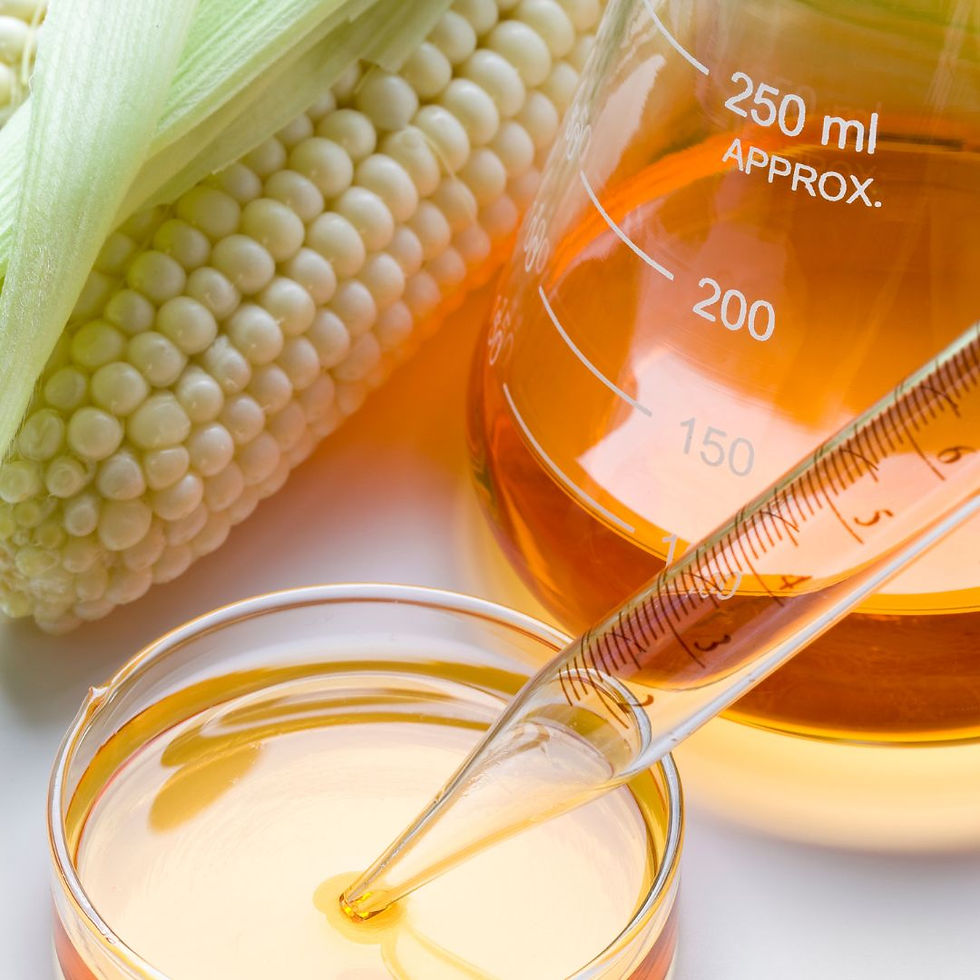The Truth About High Fructose Corn Syrup
- Kristin Finley, RD/LD
- Jun 26, 2022
- 4 min read
Updated: Jul 24, 2023

(Part 1 of 2)
It is difficult to figure out the facts about high-fructose corn syrup (HFCS). We hear that it is "natural". We read that it is made up of the same ingredients as white table sugar and honey, which is glucose and fructose. We also read that it is no more risky than white table sugar. Then we read another article that says when compared to other sugars, HFCS increases our risk for metabolic syndrome, abdominal fat and ultimately heart disease. So, what is the truth?
Well first, please be careful not to misunderstand HFCS and fructose. Fructose is the natural sugar found in fruit and is perfectly fine when it is ingested in whole foods like apples, because it comes with a host of vitamins, antioxidants, and fiber -- the good stuff. HFCS is something we create from corn and came about as a much-cheaper alternative to sugar.
HFCS was first introduced by Richard O. Marshall and Earl R. Kooi in 1957. They were, however, unsuccessful in making it viable for mass production. The industrial production process and creation was made by Dr. Y. Takasaki at Agency of Industrial Science and Technology of Ministry of International Trade and Industry of Japan in 1965–1970. Dr. Takasaki is known to many as the creator of HFCS. From about 1975 to 1985, HFCS was rapidly introduced to many processed foods and soft drinks in the U.S.
HFCS is produced by milling corn into corn starch (the sugar in corn). The corn starch is then processed to yield corn syrup, which is almost entirely glucose. Enzymes are added that change some of the glucose into fructose. The resulting syrup (after enzyme conversion) contains approximately 42% fructose and is called HFCS 42. The 42% fructose is then purified to 90% fructose, HFCS 90. In order to make HFCS 55, the HFCS 90 is mixed with HFCS 42 in the appropriate ratios to form the desired HFCS 55. HFCS is used in a number of foods, noncarbonated drinks, carbonated beverages, and baked goods.
Wow, how can this be less expensive than white table sugar??? 😊
All sugars, from white table sugar to HFCS, have some mixture of glucose and fructose. Table sugar is 50% glucose and 50% fructose, most HFCS is 45% glucose and 55% fructose, honey is 30% glucose, 40% fructose, 10% maltose and 20% water, and agave nectar is a whopping 70-90% fructose.
The Pros: HFCS is inexpensive, (who knew??) easy to transport, keeps food moist, imparts freshness and texture, prolongs shelf life, replaces some preservatives, dissolves quickly in water, performs better at browning and creating “crunch”.
The Cons: HFCS is added to many, many products increasing the consumption to extraordinary levels, made with corn heavily treated with pesticides and genetically modified, is not hunger satisfying causing higher consumption, increases body fat and cholesterol because it metabolizes into fat more easily than sugar, and fructose conversion into carbohydrates can overload the liver.
Numerous experts have agreed that research studies have yielded mixed results about the possible adverse effects of consuming HFCS. Although it is chemically similar to table sugar (sucrose), concerns have been raised about how it is processed. Some believe that our bodies react differently to HFCS than they do to other types of sugar. Research about HFCS is evolving but unfortunately most is gathered through non-human studies making comparisons oftentimes merely speculation.
So, what do I do? Well, suffice it to say that it is generally accepted that HFCS is more detrimental than traditional and natural sweeteners, such as honey, maple syrup, agave syrup, molasses and even plain, white table sugar produced from sugar cane & sugar beets and minimally processed. (Read more about white table sugar at The Sugar Association; https://www.sugar.org/sugar/real-sugar/ ) I concur with this opinion. Honestly, anything that is too altered from its natural state cannot be the same as the natural sources.
As usual, moderation is the key which may be difficult because it pops up everywhere; take a look at some common foods high in HFCS.
regular soft drinks
fruit juice & fruit drinks (if not 100% juice)
pancake syrups & jelly
popsicles
fruit-flavored yogurts
frozen yogurts
ketchup & BBQ sauces
jarred & canned pasta sauces
canned soups
canned fruits (if not in its own 100% juice)
breakfast cereals
breakfast bars
spray salad dressings
What is the bottom line? Even though HFCS has the same ingredients as table sugar, they are combined in a lab. In table sugar, the glucose and fructose are bound by nature with minimal processing. Time will tell if, in fact, HFCS is more harmful than other forms of sugar or sweetener.
For now, we recommend to avoid HFCS when possible. Start with reading the food label then avoid or at least limit added sweeteners. If adding a sweetener is necessary, choose a littler healthier source of sweetener like fresh pureed fruit, 100% pure or raw honey, 100% maple syrup, 100% fruit spread, black strap molasses or at least raw sugar (less processed). So, even though a spoonful of sugar may make the medicine go down, it's probably part of the reason for it!
Stay tuned for Part 2 of understanding HFCS with a focus on how it breaks down and its use in carbonated beverages (aka soda, soda pop, pop, soft drink, etc.)
Click here for our podcast!
https://bewell365.podbean.com/e/the-truth-about-high-fructose-corn-syrup-part-2/

































Comments